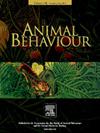Homing navigation is optimized to diurnal constraints in a tropical seabird, the red-footed booby
IF 2.3
2区 生物学
Q2 BEHAVIORAL SCIENCES
引用次数: 0
Abstract
When navigating homewards, central-place foragers can use landmarks and sun angle to adjust their return movement behaviour. However, for tropical oceanic species foraging from low-lying atolls, the effectiveness of their homing journeys on their time returns remains unclear. Thus, in this study, the navigation behaviour of red-footed boobies, Sula sula rubripes, in the Chagos Archipelago, central Indian Ocean, was investigated. Using GPS tracking data from 207 breeding adults across four colonies, the homing duration, bearing and trajectory straightness during central-place foraging were explored to elucidate the navigational constraints and temporal dynamics. Return distances and orientations were modelled in relation to the time of day and distance to the colony to assess whether birds adjust their homing behaviour to return before dusk. We found that red-footed boobies navigated efficiently back to their colony on fast, straight and direct flights and adjusted their homing behaviour to arrive at the colony around dusk: the closer to the evening twilight they start their homing journey, the shorter, faster and more direct their routes become. These findings provide a comprehensive understanding of seabird navigation in tropical environments, as well as insights into the adaptive mechanism underlying successful navigation over expansive oceanic territories.
求助全文
约1分钟内获得全文
求助全文
来源期刊

Animal Behaviour
生物-动物学
CiteScore
4.60
自引率
8.00%
发文量
236
审稿时长
10.2 weeks
期刊介绍:
Growing interest in behavioural biology and the international reputation of Animal Behaviour prompted an expansion to monthly publication in 1989. Animal Behaviour continues to be the journal of choice for biologists, ethologists, psychologists, physiologists, and veterinarians with an interest in the subject.
 求助内容:
求助内容: 应助结果提醒方式:
应助结果提醒方式:


